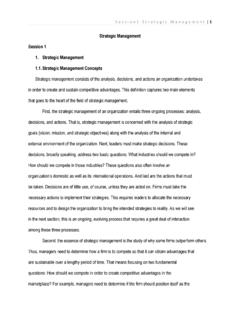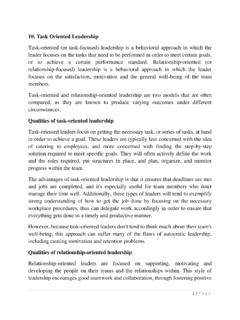Transcription of Systems development life cycle 6.1 INTRODUCTION: systems ...
1 Page 1 of 11 Systems development life cycle INTRODUCTION: The Systems development life cycle (SDLC), also referred to as the application development life- cycle , is a term used in Systems engineering , information Systems and software engineering to describe a process for planning, creating, testing, and deploying an information system. The Systems development life- cycle concept applies to a range of hardware and software configurations, as a system can be composed of hardware only, software only, or a combination of both. Overview A Systems development life cycle is composed of a number of clearly defined and distinct work phases which are used by Systems engineers and Systems developers to plan for, design, build, test, and deliver information Systems . Like anything that is manufactured on an assembly line, an SDLC aims to produce high quality Systems that meet or exceed customer expectations, based on customer requirements, by delivering Systems which move through each clearly defined phase, within scheduled time-frames and cost estimates.
2 Computer Systems are complex and often (especially with the recent rise of service-oriented architecture) link multiple traditional Systems potentially supplied by different software vendors. To manage this level of complexity, a number of SDLC models or methodologies have been created, such as "waterfall"; "spiral"; "Agile software development "; "rapid prototyping"; "incremental"; and "synchronize and stabilize". SDLC can be described along a spectrum of agile to iterative to sequential. Agile methodologies, such as XP and Scrum, focus on lightweight processes which allow for rapid changes (without necessarily following the pattern of SDLC approach) along the development cycle . Iterative methodologies, such as Rational Unified Process and dynamic Systems development method, focus on limited project scope and expanding or improving products by multiple iterations. Sequential or big-design-up-front (BDUF) models, such as waterfall, focus on complete and correct planning to guide large projects and risks to successful and predictable results.
3 Other models, such as anamorphic development , tend to focus on a form of development that is guided by project scope and adaptive iterations of feature development . In project management a project can be defined both with a project life cycle (PLC) and an SDLC, during which slightly different activities occur. According to Taylor (2004) "the project life cycle encompasses all the activities of the project, Page 2 of 11 while the Systems development life cycle focuses on realizing the product requirements". SDLC is used during the development of an IT project, it describes the different stages involved in the project from the drawing board, through the completion of the project. History The product life cycle describes the process for building information Systems in a very deliberate, structured and methodical way, reiterating each stage of the product's life. The Systems development life cycle , according to Elliott & Strachan & Radford (2004), "originated in the 1960s, to develop large scale functional business Systems in an age of large scale business conglomerates.
4 Information Systems activities revolved around heavy data processing and number crunching routines". Several Systems development frameworks have been partly based on SDLC, such as the structured Systems analysis and design method (SSADM) produced for the UK government Office of Government Commerce in the 1980s. Ever since, according to Elliott (2004), "the traditional life cycle approaches to Systems development have been increasingly replaced with alternative approaches and frameworks, which attempted to overcome some of the inherent deficiencies of the traditional SDLC". Phases The system development life cycle framework provides a sequence of activities for system designers and developers to follow. It consists of a set of steps or phases in which each phase of the SDLC uses the results of the previous one. The SDLC adheres to important phases that are essential for developers, such as planning, analysis, design, and implementation, and are explained in the section below.
5 It includes evaluation of present system, information gathering, and feasibility study and request approval. A number of SDLC models have been created: waterfall, fountain, and spiral, build and fix, rapid prototyping, incremental, and synchronize and stabilize. The oldest of these, and the best known, is the waterfall model: a sequence of stages in which the output of each stage becomes the input for the next. These stages can be characterized and divided up in different ways, including the following: Page 3 of 11 Preliminary analysis: The objective of phase 1 is to conduct a preliminary analysis, propose alternative solutions, describe costs and benefits and submit a preliminary plan with recommendations. Conduct the preliminary analysis: in this step, you need to find out the organization's objectives and the nature and scope of the problem under study. Even if a problem refers only to a small segment of the organization itself then you need to find out what the objectives of the organization itself are.
6 Then you need to see how the problem being studied fits in with them. Propose alternative solutions: In digging into the organization's objectives and specific problems, you may have already covered some solutions. Alternate proposals may come from interviewing employees, clients, suppliers, and/or consultants. You can also study what competitors are doing. With this data, you will have three choices: leave the system as is, improve it, or develop a new system. Describe the costs and benefits. Systems analysis, requirements definition: Defines project goals into defined functions and operation of the intended application. Analyzes end-user information needs. Systems design: Describes desired features and operations in detail, including screen layouts, business rules, process diagrams, pseudo-code and other documentation. development : The real code is written here. Integration and testing: Brings all the pieces together into a special testing environment, then checks for errors, bugs and interoperability.
7 Acceptance, installation, deployment: The final stage of initial development , where the software is put into production and runs actual business. Maintenance: During the maintenance stage of the SDLC, the system is assessed to ensure it does not become obsolete. This is also where changes are made to initial software. It involves continuous evaluation of the system in terms of its performance. Evaluation: Some companies do not view this as an official stage of the SDLC, but is it an important part of the life cycle . Evaluation step is an Page 4 of 11 extension of the Maintenance stage, and may be referred to in some circles as Post-implementation Review. This is where the system that was developed, as well as the entire process, is evaluated. Some of the questions that need to be answered include: does the newly implemented system meet the initial business requirements and objectives?
8 Is the system reliable and fault-tolerant? Does the system function according to the approved functional requirements? In addition to evaluating the software that was released, it is important to assess the effectiveness of the development process. If there are any aspects of the entire process, or certain stages, that management is not satisfied with, this is the time to improve. Evaluation and assessment is a difficult issue. However, the company must reflect on the process and address weaknesses. Disposal: In this phase, plans are developed for discarding system information, hardware and software in making the transition to a new system. The purpose here is to properly move, archive, discard or destroy information, hardware and software that is being replaced, in a matter that prevents any possibility of unauthorized disclosure of sensitive data. The disposal activities ensure proper migration to a new system.
9 Particular emphasis is given to proper preservation and archival of data processed by the previous system. All of this should be done in accordance with the organization's security requirements.[8] In the following example these stages of the Systems development life cycle are divided in ten steps from definition to creation and modification of IT work products: The tenth phase occurs when the system is disposed of and the task performed is either eliminated or transferred to other Systems . The tasks and work products for each phase are described in subsequent chapters. Not every project will require that the phases be sequentially executed. However, the phases are interdependent. Depending upon the size and complexity of the project, phases may be combined or may overlap. System investigation The system investigate the IT proposal. During this step, we must consider all current priorities that would be affected and how they should be handled.
10 Before any system planning is done, a feasibility study should be conducted to determine if creating a new or improved system is a viable solution. This will help to Page 5 of 11 determine the costs, benefits, resource requirements, and specific user needs required for completion. The development process can only continue once management approves of the recommendations from the feasibility study. Following are different components of the feasibility study: Operational feasibility Economic feasibility Technical feasibility Human factors feasibility Legal/Political feasibility System analysis The goal of system analysis is to determine where the problem is in an attempt to fix the system. This step involves breaking down the system in different pieces to analyze the situation, analyzing project goals, breaking down what needs to be created and attempting to engage users so that definite requirements can be defined.














